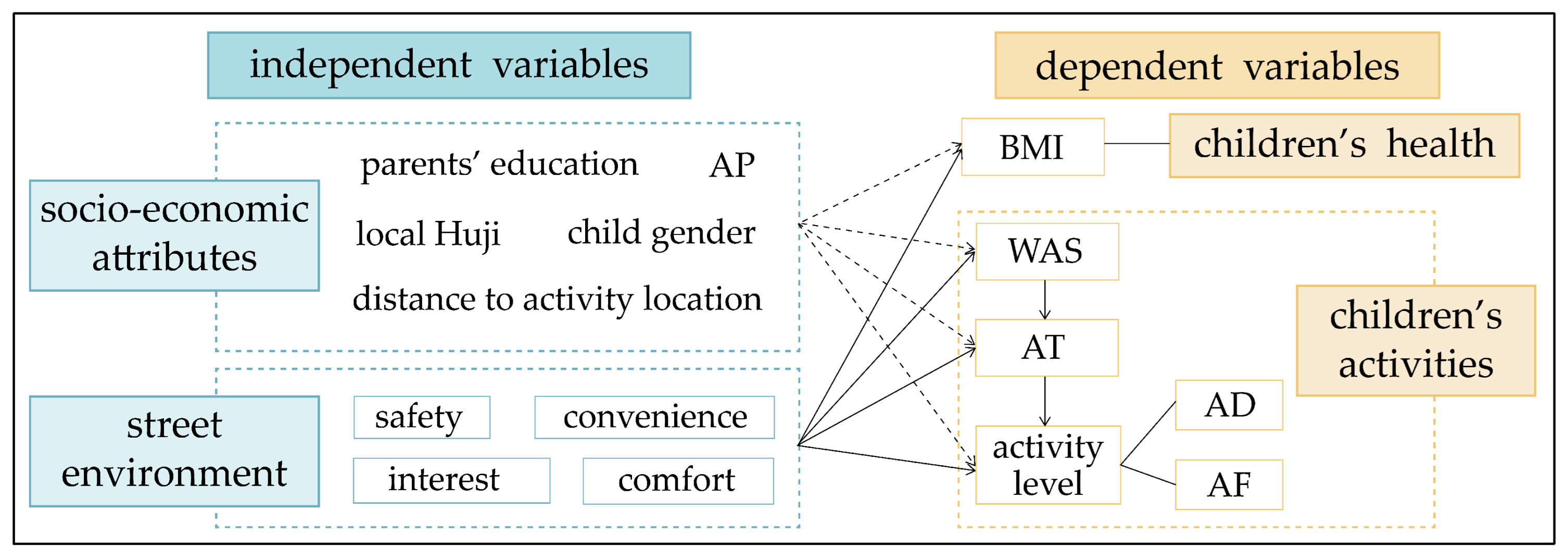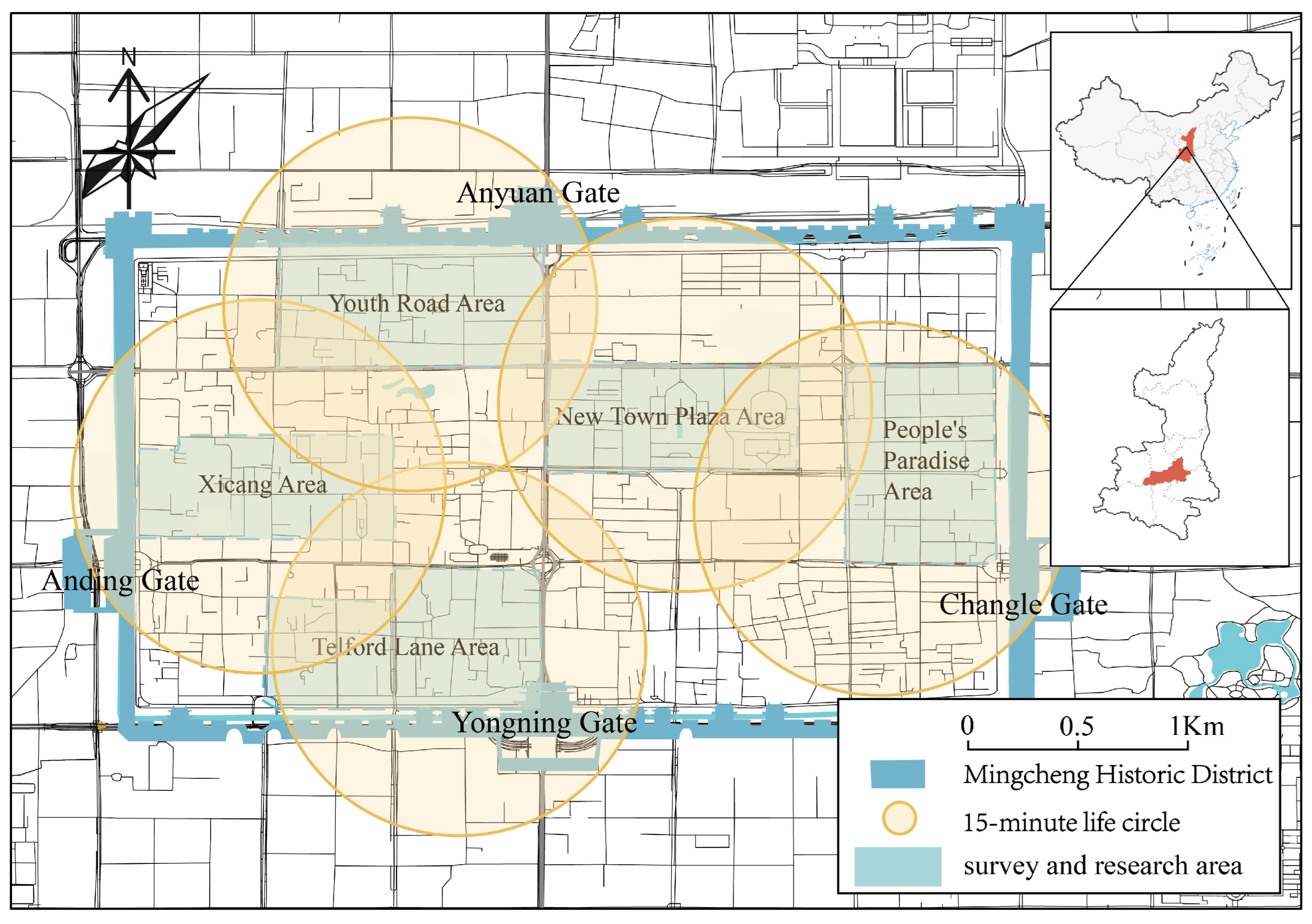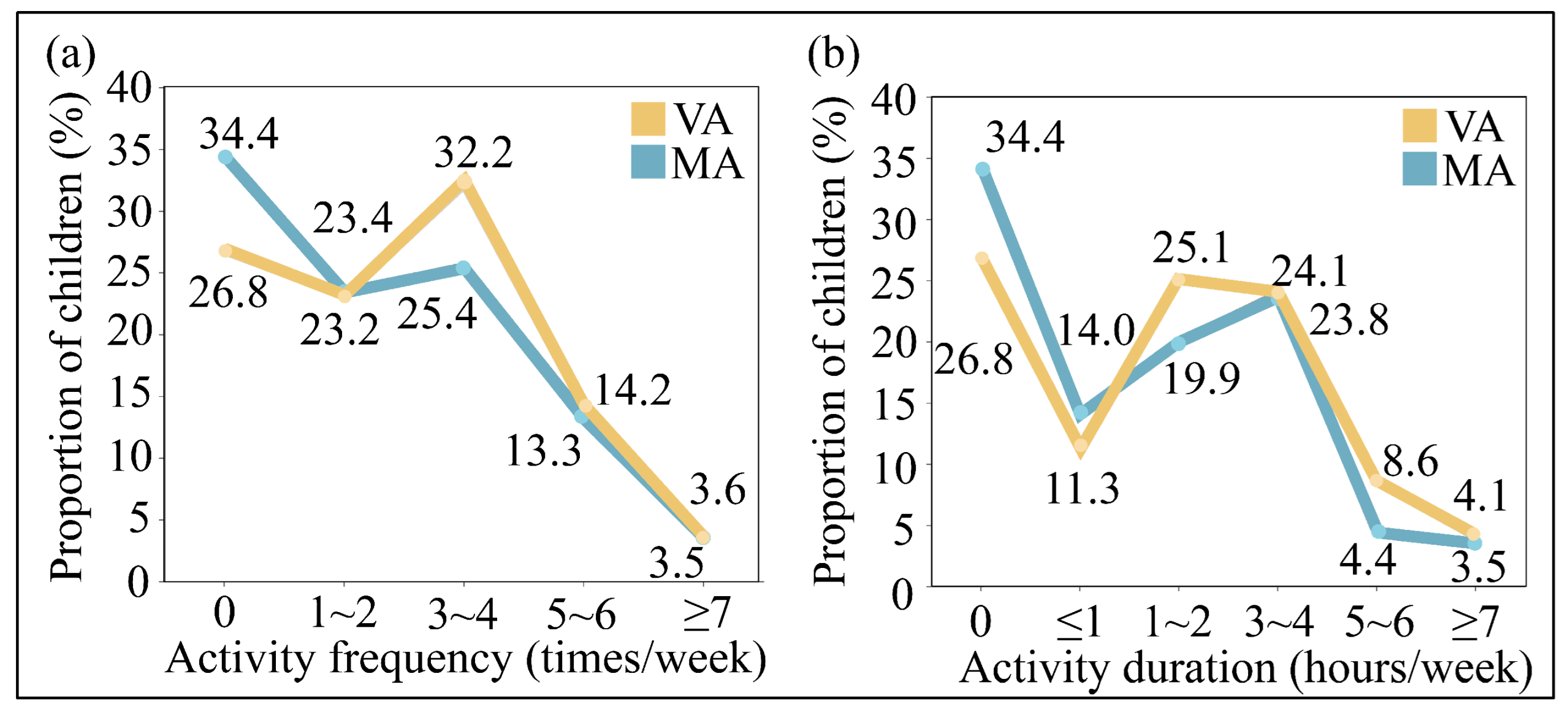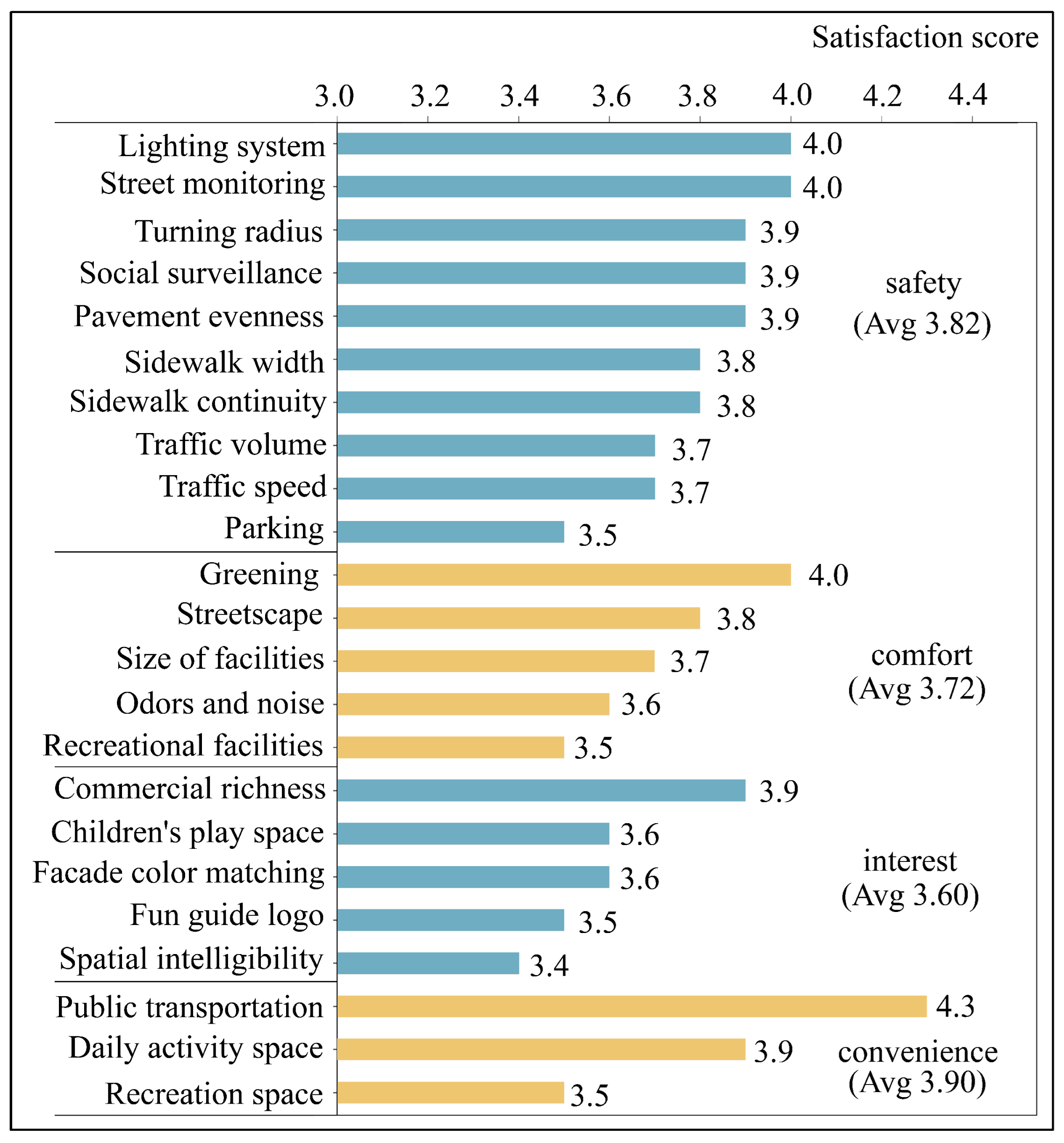Health Perspectives on the Impact of Historic Neighborhood Street Environments on Children’s Activities
Abstract
1. Introduction
2. Research Material
2.1. Research Indicator
2.1.1. Dependent Variables
2.1.2. Independent Variables
2.2. Research Data
2.3. Research Method
3. Children’s Activities on Streets
3.1. The Characteristics of Children’s Activities on Streets
3.1.1. Children’s BMI, WAS, and AT
3.1.2. Children’s AF and AD on Streets
3.2. Children’s Satisfaction of SE
4. Results
4.1. Relationships between Children’s BMI, WAS, AT, and SE
4.2. Relationships between Children’s AF, AD, and SE
5. Conclusions and Outlook
Supplementary Materials
Author Contributions
Funding
Institutional Review Board Statement
Informed Consent Statement
Data Availability Statement
Conflicts of Interest
References
- Coutinho, S.R.; Andersen, O.K.; Lien, N.; Gebremariam, M.K. Neighborhood deprivation, built environment, and overweight in adolescents in the city of Oslo. BMC Public Health 2023, 23, 812. [Google Scholar] [CrossRef] [PubMed]
- Opinions of the Ministry of Education and other five departments on comprehensively strengthening and improving school hygiene and health education in the new era. China Sch. Health 2021, 42, 1274–1275. (In Chinese)
- Koskela-Staples Natalie, C.; Yourell, J.L.; Fedele, D.A.; Doty, J. Physical Activity Engagement: Perspectives from Adolescents With Comorbid Asthma and Overweight/Obesity and Their Caregivers. J. Pediatr. Psychol. 2023, 48, 707–719. [Google Scholar] [CrossRef] [PubMed]
- Orellana, D.; Hermida, C.; Quezada, A.; Andrade, J.; Ballari, D. Children’s Active Mobility to School: Evidence from Two Andean Cities. Sustainability 2024, 16, 2745. [Google Scholar] [CrossRef]
- General Rules for Street Design in Xi’an, Xi’an Municipal Bureau of Natural Resources and Planning. Available online: http://zygh.xa.gov.cn/web_files/zygh/attachment/202001/19/20200119150930634668472109995003904.pdf (accessed on 19 January 2020). (In Chinese)
- Cao, B. Research on Micro-Renewal Strategy of Historic Neighborhoods under the Background of Inventory Planning. Ph.D. Thesis, Anhui University of Technology, Maanshan, China, 2023. (In Chinese). [Google Scholar]
- Riggio, E. Child friendly cities: Good governance in the best interests of the child. Environ. Urban 2002, 14, 45–58. [Google Scholar] [CrossRef]
- Acciai, F.; DeWeese, R.S.; Lloyd, K.; Yedidia, M.J.; Kennedy, M.; DiSantis, K.I.; Tulloch, D.; Ohri-Vachaspati, P. The relationship between changes in neighborhood physical environment and changes in physical activity among children: A prospective cohort study. Int. J. Behav. Nutr. Phys. Act. 2023, 20, 82. [Google Scholar] [CrossRef] [PubMed]
- Zhang, L.; Xu, X.; Guo, Y. The Impact of a Child-Friendly Design on Children’s Activities in Urban Community Pocket Parks. Sustainability 2023, 15, 10073. [Google Scholar] [CrossRef]
- Guo, D.; Shi, Y.; Chen, R. Environmental affordances and children’s needs: Insights from child-friendly community streets in China. Front. Archit. Res. 2023, 12, 411–422. [Google Scholar] [CrossRef]
- He, Y.; Xiong, Y.; Man, X.; Cao, Y. The Construction and Application of Community Street Space Health Promotion from the Perspective of Biophilia Theory: Taking the Cotton and Hemp Lane and Government Lane in Xixian as Examples. Intell. Build. Smart City 2023, 11, 45–47. (In Chinese) [Google Scholar]
- Jin, H. Influence of Urban Street Greening Design under the Concept of Green Healthy Cities: A Case Study of Hefei City. J. Landsc. Res. 2023, 15, 31–34, 40. [Google Scholar]
- Global Designing Cities Initiative (GDCI). Children’s Street Design; Global Designing Cities Initiative (GDCI): New York, NY, USA, 2020. [Google Scholar]
- WHO Guidelines on Physical Activity and Sedentary Behavior; World Health Organization: Geneva, Switzerland, 2020. [PubMed]
- Van Camp, C.M.; Batchelder, S.R.; Irwin Helvey, C. Individual heart rate assessment and bout analysis of vigorous physical activity in children. J. Appl. Behav. Anal. 2022, 55, 782–798. [Google Scholar] [CrossRef] [PubMed]
- Benavente-Marín, J.C.; Barón-López, F.J.; Barcenilla, B.G.; Abril, G.L.; Aguirre, J.M.R.; Pérez-Farinós, N.; Wärnberg, J. Adherence to the WHO recommendation of three weekly days of vigorous intensity activities in children: An accelerometry study of vigorous physical activity bouts. PeerJ 2024, 12, e16815. [Google Scholar] [CrossRef]
- Igel, U.; Gausche, R.; Krapf, A.; Lück, M.; Kiess, W.; Grande, G. “Movement-enhancing footpaths”—A natural experiment on street design and physical activity in children in a deprived district of Leipzig, Germany. Prev. Med. Rep. 2020, 20, 101197. [Google Scholar] [CrossRef] [PubMed]
- Gericke, C.; Pienaar, A.E.; Gerber, B.; Monyeki, M.A. Relationships between moderate vigorous physical activity, motor- and health-related fitness and motor skills in children. Afr. J. Prim. Health Care Fam. Med. 2024, 16, e1–e12. [Google Scholar] [CrossRef]
- Andersen, K.O.; Gebremariam, K.M.; Kaupang, B.O.; Lien, N.; Kolle, E. Built for movement: Neighborhoods and adolescent physical activity behaviors, and the moderating role of socioeconomic position and gender. Health Place 2024, 89, 103313. [Google Scholar] [CrossRef]
- Tang, P.; Yang, D.; Dong, N. The Effect of Intergenerational Parenting Mode on Children’s Outdoor Activities: A Case Study of Downtown Shanghai Communities. Sustainability 2023, 15, 14658. [Google Scholar] [CrossRef]
- Ruedl, G.; Cocca, A.; Wirnitzer, K.C.; Tanous, D.; Drenowatz, C.; Niedermeier, M. Primary school children’s health and its association with physical fitness development and health-related factors. AIMS Public Health 2024, 11, 11–18. [Google Scholar] [CrossRef] [PubMed]
- Berg, P.; Rinne, T.; Hakala, P.; Pesola, A.J. Children’s independent mobility and activity spaces during COVID-19 in Finland. Child. Geogr. 2023, 21, 624–638. [Google Scholar] [CrossRef]
- Zhao, D. A Study on the Renewal Design of Streets around Elementary Schools Based on the Concept of Child-Friendly. Ph.D. Thesis, Jiangxi University of Finance and Economics, Nanchang, China, 2023. (In Chinese). [Google Scholar]
- Tian, P.; Kim, S.; Wang, J. A study on the Safety Evaluation System of Outdoor Children’s Activity Space in Residential Area. J. Sociol. Ethnol. 2023, 5, 36–44. (In Chinese) [Google Scholar]
- Zhang, Y.; Koene, M.; Chen, C.; Wagenaar, C.; Reijneveld, S.A. Associations between the built environment and physical activity in children, adults and older people: A narrative review of reviews. Prev. Med. 2024, 180, 107856. [Google Scholar] [CrossRef]
- Garau, C.; Annunziata, A. Smart city governance and children’s agency: An assessment of the green infrastructure impact on children’s activities in Cagliari (Italy) with the tool “opportunities for children in urban spaces (OCUS)”. Sustainability 2019, 11, 4848. [Google Scholar] [CrossRef]
- Chibane, O.; Hamouda, A. The Relationship Between Spatial Configuration of Residential Quarters and Children’s Outdoor Activity. Prost. Znan. Časopis Za Arhit. I Urban. 2022, 30, 24–33. [Google Scholar] [CrossRef]
- Narimani, N.; Karimi, A.; Brown, R.D. Effects of street orientation and tree species thermal comfort within urban canyons in a hot, dry climate. Ecol. Inform. 2022, 69, 101671. [Google Scholar] [CrossRef]
- Pilaiporn, N.; Kiyoko, K. Children’s spaces and creative adaptation in a high-density neighborhood of the Bangkok metropolitan region: A case study of the Duang Khae neighbourhood. J. Asian Archit. Build. Eng. 2023, 22, 1889–1902. [Google Scholar]
- Andrea, N.; Jasper, S.; Trina, R.; George, P.; Boruff, B.; Trost, S.G.; Christian, H. The moderating role of parent perceptions in relationships between objectively measured neighbourhood environment attributes and pre-schooler’s physical activity: Findings from the PLAYCE study. Health Place 2023, 81, 103030. [Google Scholar]
- Hu, X.; Lu, Y.; Zheng, Y.; Zou, Y. Evaluation of the accessibility of community children’s activity sites based on the slow-moving system. J. Fuzhou Univ. (Philos. Soc. Sci. Ed.) 2023, 37, 46–55. (In Chinese) [Google Scholar]
- World Health Organization. Child Development Standards, [EB/OL]. 27 April 2006. Available online: https://www.who.int/tools/child-growth-standards/standards (accessed on 25 July 2023).
- Lehnert, M.; Jirmus, R.; Květoňová, V.; Geletič, J.; Jurek, M.; Středová, H.; Frajer, J. Overheated children’s playgrounds in Central European cities: The effects of surfaces and shading on thermal exposure during hot summer days. Urban Clim. 2024, 55, 101873. [Google Scholar] [CrossRef]
- Namazi, Y.; Charlesworth, S.; Montazami, A.; Taleghani, M. The impact of local microclimates and Urban Greening Factor on schools’ thermal conditions during summer: A study in Coventry, UK. Build. Environ. 2024, 262, 111793. [Google Scholar] [CrossRef]
- Elena, T.; Ilaria, P.; Laura, A.P. On kids’ environmental wellbeing and their access to nature in urban heat islands: Hyperlocal microclimate analysis via surveys, modelling, and wearable sensing in urban playgrounds. Urban Clim. 2023, 49, 101447. [Google Scholar]





| Variables | Factors | Description |
|---|---|---|
| Children’s health | BMI 1 | children’s weight (kg)/[height (m)]2 |
| Children’s activity | WAS 2 | Children’s willingness to engage in activities in the street |
| AT 3 | vigorous activity (VA) 4 and moderate activity (MA) 5 | |
| AF | times per week that children engage in MA and VA on the street | |
| AD | hours per week of MA and VA on the streets by children | |
| The satisfaction of SE 6 | safety | Traffic volume, parking, traffic speed, sidewalk width, lighting system, turning radius, sidewalk continuity, social surveillance, street monitoring, pavement evenness |
| comfort | Recreational facilities, size of facilities, odors and noise, greening, streetscapes | |
| interest | Commercial richness, children’s play space, spatial intelligibility, color of the street facade, fun guide logo | |
| convenience | Recreation space, daily activity space, public transportation |
| Attribute | Sample Size (%) | BMI | WAS (%) | AT (%) | AF (Times/ Week) | AD (Hours/ Week) | |
|---|---|---|---|---|---|---|---|
| age (years old) | 6–7 | 90 (27.3%) | 16.26 | 34.4% | 46.6% | 3.77 | 3.52 |
| 8–10 | 117 (35.62%) | 18.17 | 45.2% | 57.2% | 5.47 | 5.13 | |
| 11–12 | 136 (37.08%) | 19.34 | 52.2% | 61.1% | 5.37 | 5.21 | |
| gender | boy | 197 (57.4%) | 18.95 | 62.4% | 69.5% | 6.63 | 6.49 |
| girl | 146 (42.6%) | 17.02 | 21.9% | 37.6% | 2.77 | 2.37 | |
| traffic mode to school | walk | 157 (45.7%) | 18.44 | 45.8% | 57.3% | 4.98 | 4.73 |
| non-motorized vehicle | 126 (36.7%) | 17.69 | 40.4% | 51.5% | 4.42 | 4.35 | |
| motor vehicles | 60 (17.6%) | 18.24 | 53.3% | 61.6% | 6.17 | 5.57 | |
| AP | friends | 247 (72%) | 18.17 | 43.3% | 55.8% | 5.04 | 4.76 |
| family | 83 (24.2%) | 17.88 | 48.1% | 53.0% | 4.92 | 4.74 | |
| alone | 13 (3.8%) | 19.05 | 61.5% | 76.9% | 4.31 | 4.27 | |
| parents‘ education attainment | high school | 84 (24.4%) | 18.52 | 35.7% | 58.3% | 4.29 | 4.33 |
| undergraduate | 214 (62.3%) | 17.93 | 50.0% | 56.5% | 5.14 | 4.76 | |
| master’s degree or above | 45 (13.3%) | 18.35 | 40.0% | 48.8% | 5.53 | 5.41 | |
| Local Huji | yes | 221 (67.3%) | 18.09 | 58.3% | 70.1% | 6.22 | 6.00 |
| no | 122 (32.7%) | 18.21 | 21.3% | 30.3% | 2.74 | 2.45 | |
| Total | 343 (100%) | 18.13 | 45.1% | 68.7% | 4.98 | 4.74 | |
| Explanatory Variable | BMI | WAS | AT | ||||
|---|---|---|---|---|---|---|---|
| Coefficient | Marginal Effect | Coefficient | Marginal Effect | Coefficient | Marginal Effect | ||
| socio-economic property | Parents’ education | −0.648 ** | −0.049 ** | −0.636 ** | −0.075 ** | ||
| Local Huji | 1.489 *** | 0.106 *** | |||||
| Child gender | |||||||
| AP | |||||||
| Distance to activity location | |||||||
| safety | Traffic volume | ||||||
| Parking | |||||||
| Traffic speed | −0.505 * | −0.038 * | 0.763 *** | 0.054 *** | |||
| Sidewalk width | 0.473 ** | 0.056 ** | |||||
| Lighting system | 0.624 * | 0.044 * | |||||
| Turning radius | |||||||
| Sidewalk continuity | |||||||
| Social surveillance | 0.906 *** | 0.064 *** | 0.360 * | 0.043 * | |||
| Street monitoring | −0.648 ** | −0.049 ** | |||||
| Pavement Evenness | 0.456 * | 0.035 * | |||||
| comfort | Recreational facilities | −0.661 ** | −0.050 ** | 0.832 *** | 0.032 *** | ||
| Size of facilities | 0.654 ** | 0.050 ** | |||||
| Odor and noise | −0.491 ** | −0.037 ** | 0.456 ** | 0.054 *** | |||
| Greening | −0.515 * | −0.039 * | |||||
| Streetscape | 0.476 ** | 0.056 ** | |||||
| interest | Commercial richness | 0.483 * | 0.034 * | ||||
| Children’s play space | |||||||
| Facade color matching | |||||||
| Spatial intelligibility | |||||||
| Fun guide logo | −0.425 * | −0.032 * | 0.583 ** | 0.041 ** | |||
| convenience | Public transportation | 0.677 ** | 0.048 ** | ||||
| Recreation space | −0.474 * | −0.036 * | |||||
| Daily activity space | 0.646 * | 0.046 ** | 0.427 ** | 0.051 ** | |||
| chi-square value | 215.045 *** | 314.759 *** | 215.682 *** | ||||
| predictive accuracy | 89.21% | 89.50% | 80.76% | ||||
| Explanatory Variable | Frequency of VA | Duration of VA | Frequency of MA | Duration of MA | |
|---|---|---|---|---|---|
| Coefficient | Coefficient | Coefficient | Coefficient | ||
| Socio economic attributes | Parents’ education | 0.084 ** | |||
| Local Huji | −0.087 ** | ||||
| Child gender | −0.089 ** | ||||
| AP | |||||
| Distance from home to activity location | 0.075 ** | 0.086 ** | 0.116 *** | ||
| safety | Traffic volume | ||||
| Parking | 0.138 *** | 0.160 *** | |||
| Traffic speed | 0.105 ** | ||||
| Sidewalk width | 0.195 *** | 0.173 *** | |||
| Lighting system | 0.214 *** | 0.219 *** | |||
| Turning radius | |||||
| Sidewalk continuity | |||||
| Social surveillance | |||||
| Street Monitoring | |||||
| Pavement Evenness | 0.119 ** | ||||
| comfort | Recreational facilities | ||||
| Size of facilities | 0.139 *** | 0.197 *** | 0.170 *** | ||
| Odor and noise | 0.118 ** | ||||
| Greening | 0.114 *** | 0.149 *** | |||
| Streetscape | |||||
| interest | Commercial richness | 0.097 ** | 0.134 *** | 0.156 *** | |
| Children’s play space | |||||
| Facade color matching | |||||
| Spatial intelligibility | |||||
| Fun guide logo | 0.221 *** | 0.181 *** | |||
| convenience | Public transportation | ||||
| Recreation space | 0.172 *** | 0.117 ** | 0.217 *** | ||
| Daily activity space | |||||
| R2 | 0.615 | 0.555 | 0.406 | 0.351 | |
| F | F = 59.293 | F = 51.987 | F = 38.289 | F = 36.466 | |
| D-W value | 1.707 | 1.850 | 1.904 | 1.875 | |
Disclaimer/Publisher’s Note: The statements, opinions and data contained in all publications are solely those of the individual author(s) and contributor(s) and not of MDPI and/or the editor(s). MDPI and/or the editor(s) disclaim responsibility for any injury to people or property resulting from any ideas, methods, instructions or products referred to in the content. |
© 2024 by the authors. Licensee MDPI, Basel, Switzerland. This article is an open access article distributed under the terms and conditions of the Creative Commons Attribution (CC BY) license (https://creativecommons.org/licenses/by/4.0/).
Share and Cite
Zhang, Z.; Zhai, B.; Hou, S.; Liu, S. Health Perspectives on the Impact of Historic Neighborhood Street Environments on Children’s Activities. Sustainability 2024, 16, 7345. https://doi.org/10.3390/su16177345
Zhang Z, Zhai B, Hou S, Liu S. Health Perspectives on the Impact of Historic Neighborhood Street Environments on Children’s Activities. Sustainability. 2024; 16(17):7345. https://doi.org/10.3390/su16177345
Chicago/Turabian StyleZhang, Zhanhao, Baoxin Zhai, Shangna Hou, and Sitong Liu. 2024. "Health Perspectives on the Impact of Historic Neighborhood Street Environments on Children’s Activities" Sustainability 16, no. 17: 7345. https://doi.org/10.3390/su16177345
APA StyleZhang, Z., Zhai, B., Hou, S., & Liu, S. (2024). Health Perspectives on the Impact of Historic Neighborhood Street Environments on Children’s Activities. Sustainability, 16(17), 7345. https://doi.org/10.3390/su16177345





